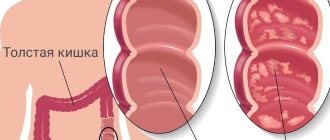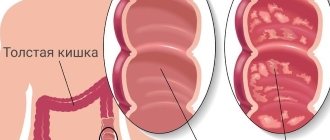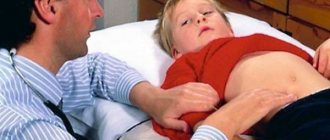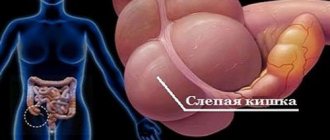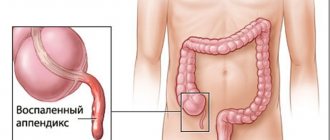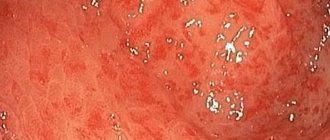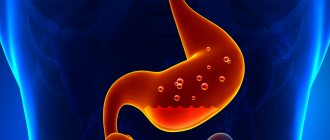Inflammatory and infectious diseases of the gastrointestinal tract can pose a great danger to humans. A particularly dangerous pathology is inflammation of the appendix of the large intestine, called appendicitis.
Complications of this pathological process can lead to an extensive infectious process in the body. Inflammation of the appendix can take a chronic form. Chronic appendicitis, the symptoms of which have their own distinctive features, requires surgical treatment.
What is appendicitis?
The appendix is the vermiform appendage of the cecum
The human intestine has a considerable extent. Each section of the intestine has its own characteristics, including its functional role and structural features.
The large intestine ensures final absorption of fluid, vitamin saturation and formation of feces. It is within the large intestine that there is a cecum with a vermiform appendix.
The vermiform appendix of the cecum is a kind of hollow, blindly closed pocket containing lymphoid tissue. Normally, food substrates do not pass from the cecum to the appendix, but there are exceptions.
The entry of food and other foreign objects into the appendix causes an acute immunological response, expressed as an inflammatory reaction.
Inflammation of the appendix of the cecum is called appendicitis. This is always an acute disease requiring urgent surgical measures. In rare cases, the disease transitions into a chronic form, when inflammation periodically stops and resumes.
The main danger of the disease is the risk of rupture of the membranes of the appendix. In this case, the inflammatory contents of the appendix end up in the peritoneal cavity and cause extensive inflammation. This complication often leads to death if not treated promptly.
Symptoms of appendicitis
Pain as a symptom of appendicitis
The manifestations of appendicitis in each patient are quite variable. It is often difficult for doctors to make such a diagnosis based only on the patient's complaints. There is also an almost asymptomatic course.
Common symptoms:
- Pain in the right abdominal area.
- Diffuse abdominal pain.
- Lack of appetite.
- Diarrhea or constipation.
- Intestinal obstruction.
- Bloating.
- Fever.
- Nausea and vomiting.
Pain with appendicitis can begin with convulsive contractions of the abdominal muscles. Gradually the pain intensifies and spreads to other areas of the abdomen. Sometimes, on the contrary, the pain becomes more localized.
There is a typical body position that is typical for patients with appendicitis. The person takes a lying position and presses his knees to his stomach. This reflex position is adopted to reduce movements that increase pain.
If severe symptoms of appendicitis appear, it is strictly forbidden to take laxatives and cleanse the intestines with an enema. These procedures may result in rupture of the appendix. The appearance of the symptoms described above should be a reason for an emergency visit to a doctor.
Self-diagnosis of the disease
If there are suspicions that nagging pain in the lower abdomen is a consequence of appendicitis, then the pathology can be diagnosed at home using the palpation method. To compare sensations, you can gently press on the left area. With appendicitis, these movements will not cause discomfort. The main thing is that movements be careful, since a ruptured appendix can provoke peritonitis.
To diagnose appendicitis, you can resort to a simple method - cough loudly.
In addition, you can press with your palm in the area of the abdomen where the greatest pain is observed. You need to hold your hand for about 10 seconds, at which point the pain subsides. Then we remove our hand and if the pain intensifies, then most likely it is acute appendicitis.
Only doctors can help in this case, so do not hesitate and urgently call a medical team. So, how to independently determine appendicitis in women by symptoms:
- the pain intensifies and then goes away;
- when coughing, laughing, hiccups and any other movements, the pain in the side increases;
- if you turn over from one side to the other, the discomfort increases;
- after vomiting there is no relief;
- Most often, attacks of appendicitis occur in the evening or at night;
- When palpating the abdomen, the patient feels severe pain.
If you suspect you have appendicitis, do not take painkillers under any circumstances.
Causes of the disease
Chronic appendicitis can have different causes
The etiology of chronic appendicitis is no different from the causes of the acute form of the disease. The main cause of inflammation of the appendix is obstruction of the lumen of the appendix.
In most cases, obstruction of the appendix occurs due to the proliferation of internal lymphoid tissue.
The lymphoid tissue of the appendix, in turn, grows due to primary infectious and inflammatory bowel diseases, such as Crohn's disease, gastroenteritis and amebiasis.
Another common cause of appendicitis is obstruction of the appendix by fecal matter. Parasites and foreign bodies can also enter the appendix.
Features of chronic appendicitis
Chronic appendicitis: Ultrasound diagnosis
A chronic course is extremely uncharacteristic of appendicitis, since inflammation of the appendix usually has an explosive nature due to the abundance of lymphoid tissue in the appendix.
However, there are cases of a mild course of the inflammatory process. In this case, appendicitis remains undiagnosed until a sudden exacerbation.
Chronic appendicitis has the same symptoms and causes as acute appendicitis. However, symptoms of the chronic form may be less pronounced or absent altogether.
The most common manifestation of the chronic form of the pathology is rare aching abdominal pain.
Appendicitis in women, elderly and children
Clinical manifestations in females resemble certain gynecological pathologies. The anomaly is associated with the close location of the appendages, and pain syndrome is present:
- with ectopic pregnancy;
- ovarian rupture;
- apoplexy, etc.
To make an accurate diagnosis, you need to pay attention to the presence of gynecological diseases and the menstrual cycle.
Some specific manifestations of appendicitis are present in the elderly, children, pregnant women and with an abnormal location of the appendix.
The following clinical signs are typical for babies:
- diarrhea with frequent vomiting;
- febrile temperature indicators;
- decreased activity - the child loses interest in toys;
- lethargy, moodiness;
- anxiety - with increasing discomfort.
In old age, the symptomatic picture is different:
- temperature rise does not always occur;
- the pulse remains within standard limits - without increasing heart rate;
- there are mild signs of abdominal irritation.
At an older age, the clinical manifestations of appendicitis resemble a neoplasm located in the area of the cecum. During pregnancy, the pain syndrome is localized over the iliac region - due to the upward elevation of the intestines against the background of an enlarged uterus.
Diagnostics
Chronic appendicitis: surgical treatment
Diagnosis of appendicitis always begins with identifying complaints and examining the patient. The doctor will look for tenderness in the lower right quadrant of the abdomen. In a pregnant woman, pain may occur slightly above the standard area.
With perforation, the abdomen will be slightly distended and tense. There are several diagnostic tests for appendicitis. First, the doctor will order a complete blood test, the results of which will determine the presence of a bacterial infection.
Further actions will depend on the result of the analysis and the patient’s condition. Other laboratory tests:
- C-reactive protein test.
- Liver and pancreas tests.
- Urinalysis (to exclude urinary tract pathology).
- HCG analysis (exclusion of early ectopic pregnancy in women of childbearing age).
- Test for uric 5-hydroxyindoleacetic acid (5-HIAA).
Instrumental studies play an important role in the diagnosis of appendicitis:
Treatment methods
Diet after appendicitis is necessary!
Treatment of acute and chronic appendicitis is almost always limited to surgical methods, since conservative therapy does not eliminate the source of inflammation. The type of surgical intervention depends on the course of the disease and the characteristics of the patient.
If an abscess that has not yet ruptured is detected, the doctor may first prescribe antimicrobial drugs. The doctor then drains the appendix cavity by placing a special tube into the abdominal cavity.
After drainage and treatment of the infection, the patient will undergo an appendectomy, during which the appendix will be completely removed. Draining the appendix and treating infection before surgery helps avoid the risk of abdominal infection during surgery.
A ruptured abscess requires an emergency appendectomy. In this case, every hour matters. An open operation will be performed, since laparoscopy for peritonitis is less effective.
In rare cases, a patient with appendicitis recovers without surgery. Such cases include the chronic form of appendicitis. If normal test results are revealed, treatment will be limited to antibiotics and a strict diet. However, you should not rely on the possibility of non-surgical treatment.
You can learn how laparoscopic surgery for appendicitis is performed from the video:
How is appendicitis removed?
Removal of appendicitis (appendectomy) is performed through open surgery or through a minimally invasive procedure called laparoscopic appendectomy. In open surgery, the appendix is cut out through a small incision in the lower right side of the abdomen. The intervention is carried out under intubation (endotracheal) anesthesia: the patient is immersed in a state of deep medicated sleep with complete relaxation of the muscles. The operation lasts up to one hour.
During laparoscopic surgery, the appendix is removed through a puncture in the navel. The advantages of laparoscopic appendectomy include low trauma and rapid rehabilitation. The scar from appendicitis removal after minimally invasive surgery is almost invisible. Laparoscopy minimizes possible postoperative complications. After a laparoscopic appendectomy, the risk of adhesions after appendicitis, which can lead to the sticking of internal organs, is much lower.
